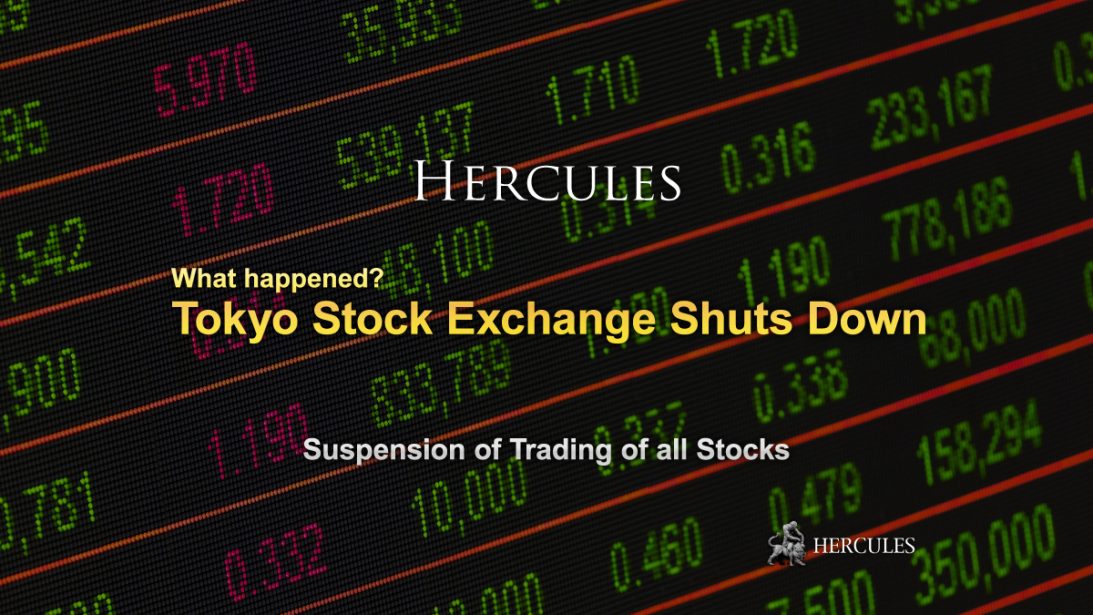Categories
What happened? Tokyo Stock Exchange suspends trading of all stocks
Tokyo Stock Exchange has closed the trading of all stocks on October 1st 2020.


- Tokyo Stock Exchange shuts down on October 1st
- What happened to Tokyo Stock Exchange?
- TSE’s frequent troubles in the past
Tokyo Stock Exchange shuts down on October 1st
On the 1st October, the Tokyo Stock Exchange suspended trading of all stocks from 9:00 am due to a failure in the distribution of market information.
Due to a system failure on the Tokyo Stock Exchange, the Nikkei Stock Average (225 types) and the Tokyo Stock Exchange Stock Index (TOPIX), which are the major stock indexes of the Tokyo stock market, did not work properly and became immobile.
The Tokyo Stock Exchange announced that it will suspend trading of all stocks throughout the day.
Regarding the system failure, it was revealed that it is unlikely that it was caused by unauthorized access from the outside.
The other exchanges in Japan including Sapporo Stock Exchange, Nagoya Stock Exchange, and Fukuoka Stock Exchange announced on the 1st that they have also stopped trading all stocks.
Among the suspension of all of the activities of the above exchanges, Japan Exchange Group (JPX) announced that trading of stock index futures etc. is being carried out as usual on the Osaka Exchange.
Go to Hercules.Finance Main Page
What happened to Tokyo Stock Exchange?
The Tokyo Stock Exchange announced on the 1st that it will cancel trading all day due to the suspension of distribution of market information such as stock prices.
Trading of all stocks has been suspended since the start of trading at 9 am in October 1st.
It is the first time since November 2005 that the trading of all stocks has been suspended on the TSE due to a system failure.
This is the first time that trading has been suspended all day since the systematization of trading in 1999.
It was the day of the announcement of the BOJ Tankan, an important economic indicator that can move stock prices.
Companies and securities companies were forced to respond to the unusual situation that disrupted trading opportunities.
The impact of the outage of exchanges on the core infrastructure of the economy is widespread, and some are worried that it will undermine Japan’s confidence in improving the status of international financial centers.
The Osaka Exchange, which handles financial derivatives such as futures, continued operating normally.
Transactions are also conducted on the private trading system (PTS) operated by Japan Next Securities, etc., and transactions of multiple individual stocks have been completed on the day.
The Nagoya Stock Exchange announced that it will suspend trading of all stocks on the name certificate due to the failure that occurred on the Tokyo Stock Exchange.
Similarly, the Sapporo Stock Exchange and the Fukuoka Stock Exchange have stopped trading all stocks.
Since Nagoya Stock Exchange uses the TSE system, transactions cannot be made due to the system obstacles.
Various stock indexes such as the Nikkei Stock Average and the Tokyo Stock Price Index (TOPIX) have not been traded for the day.
Exchange-traded funds (ETFs), infrastructure funds, and bonds with stock acquisition rights have also stopped trading.
System Error on Tokyo Stock Exchange
According to the Tokyo Stock Exchange, the trading system can be broadly divided into two networks.
There is an “order trading network” that processes buy and sell orders and an “operational network” that is the basis of the system.
This time, a problem occurred in a part of the server device of the “operational network”.
One of the devices called “shared disk devices” broke down, switching to the other device did not work, and the backup did not work.
As a result, the impact of the defect has spread to the information provision system built into the “order trading network”.
It was no longer possible to distribute important information for investors, such as the Nikkei Stock Average, stock prices of individual stocks, and the status of successful trading.
TSE introduced “Arrowhead”, which is a system for the entire transaction, in January 2010 and just renewed it in November last year.
Why did a problem occur and the backup did not work?
They are investigating the system developed by “Fujitsu”.
Go to Hercules.Finance Main Page
Transaction stopped at Nagoya Stock Exchange
Due to the system trouble on the Tokyo Stock Exchange, transactions on all stocks have been suspended on the Nagoya Stock Exchange.
Due to a problem with the system that distributes information such as stock prices that occurred before 9 am on the 1st at the Tokyo Stock Exchange, the Nagoya Stock Exchange in Nagoya City also stopped trading for all stocks and placed orders for buying and selling.
At the trading control office of the Nagoya Stock Exchange, the stock price was not displayed on the screen, and it was preparing to start trading promptly when the system was restored to the computer.
Nagoya Stock Exchange that is doing the buying and selling using the same system as the Tokyo Stock Exchange, couldn’t be recovered by itself.
The Nagoya Stock Exchange is collecting information while contacting the Tokyo Stock Exchange.
Transaction stopped at Sapporo Stock Exchange
The Sapporo Stock Exchange has also stopped trading for the listed stocks since the morning of the 1st.
After the suspension, the display on the monitor installed in the Sapporo Stock Exchange was not updated after 9 am when the transaction started, and the closing price of the stock price on the 30th was displayed as it was.
According to the Sapporo Stock Exchange, the transaction has been suspended for the first time since the Hokkaido Eastern Iburi Earthquake in September, and after 9 am, inquiries from securities companies and investors flooded in.
Osaka Exchange as usual
The Osaka Exchange, which handles futures of the Nikkei Stock Average, had no impact and transactions are conducted as usual.
The Osaka Exchange, which is operated under the Japan Exchange Group, handles various financial derivatives, such as Nikkei Stock Average futures.
The board on the Osaka Exchange also shows the Nikkei Stock Average traded on the Tokyo Stock Exchange, and there was no price movement of the index even on the Osaka Exchange.
TSE’s frequent troubles in the past
On the Tokyo Stock Exchange, troubles such as suspension of transactions have frequently occurred in the past.
In January 2006, the volume of transactions surged due to the “Livedoor incident” and reached the limit of the processing capacity of the system, and trading was completely stopped in the afternoon.
In November 2005, a problem occurred in the trading system for stocks, etc., which made it impossible to accept orders, and the transaction was completely suspended for 3 hours.
Recently, in October 2018, one of the four systems that accept orders from securities companies failed, and some securities companies were unable to buy or sell stocks or ETFs (exchange-traded funds).











